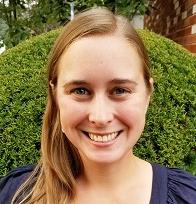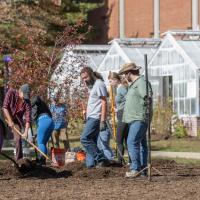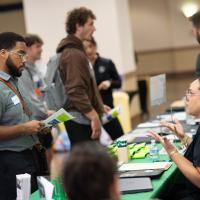
Westfield State student-led restoration ecology project to remove invasive plants along local rivers

Westfield State University Assistant Professor of Environmental Science Lauren DiCarlo, Ph.D., presented an invasive plant management project to the Westfield Conservation Commission on Feb. 23. The proposal was a capstone project for Westfield State student Nicolas Pietroniro ’20, who was the first student to graduate with the University’s new restoration ecology minor.
The student-led proposal seeks to remove invasive species on Westfield State Foundation- and state-owned properties at three sites along the Westfield and Little rivers.
“The Conservation Commission approved the proposal, meaning that we now have a permit to start the project,” explained DiCarlo. “The project will begin in the next few weeks, with students removing invasives down by the Westfield River and will continue for the next five years. At that time we can file to renew the permit.”
Within 10 feet of the rivers, plants may only be cut, but elsewhere there may be root removal. The most prevalent of invasive species is the Japanese burning bush, but others include knotweed, privet, oriental bittersweet, garlic mustard, Japanese barberry, common buckwheat, and multiflora rose.
“This project was Nick’s capstone for the restoration ecology minor, which I advise. I have known Nick for several years,” said DiCarlo. “We first started to discuss the project at the beginning of the fall 2020 semester.”
As DiCarlo and Pietroniro contacted several individuals and local organizations to provide feedback on the project, they also reached out to Karen Leigh, a Westfield State instructor who teaches the University’s “Environmental Science Wetlands” course.
A native of Agawam, Pietroniro earned a B.S. in environmental science and will begin his career in the field this upcoming spring. He wrote the proposal and collected data during the fall semester to submit the project for approval in December 2020. After approval from the Massachusetts Department of Environmental Protection and the Massachusetts Natural Heritage and Endangered Species Program, it was shared with the Westfield Conservation Commission.
The project is just one example of the research collaborations between students and faculty at Westfield State University.
“Student-faculty collaborative projects give students an opportunity to take their own original project and push it to the next level,” said Pietroniro. “In this project, Dr. DiCarlo gave me the opportunity to take my project further than I could have on my own.”
Said DiCarlo: “The project will not only benefit the City of Westfield and the Westfield State campus, but it will also provide many students hands-on experience in invasive species removal. There are also many other opportunities for faculty and students to build off the project and conduct additional field research.”
As invasive species are one of the greatest threats to ecosystems, DiCarlo believes that many students in the environmental science field will work with them in their careers.
“These opportunities could include developing plans to remove invasives and restore habitat for a nonprofit or government organization, or developing Notice of Intent proposals, such as this one, for a consulting firm,” DiCarlo said.
The Westfield State University Environmental Science Department has 150 students, and each class will participate in the field project in groups of 18–24 individuals.
“Working with wetlands and permitting is a rewarding and popular career choice among environmental science students,” said Pietroniro. “This is partly due to protective laws in Massachusetts aimed at preserving wetlands and waterways. In this project, a lot of the work that was done resembles what people in wetland permitting, habitat assessment, and ecological restoration fields do.”


